The 2016 Razer Blade Pro Review
by Brandon Chester on March 6, 2017 8:00 AM EST- Posted in
- Laptops
- Razer
- Razer Blade Pro
GPU Performance
The headline feature of the 2016 Razer Blade Pro is definitely its use of NVIDIA's GTX 1080 GPU. NVIDIA's Pascal generation of GPUs has brought us to the point where you really can get essentially the same GPU performance from a laptop as a desktop, although the base clock speed is slightly lower than its desktop counterpart, and thermals can play a large role in laptop performance. GTX 1080 is still NVIDIA's flagship GPU, and the Blade Pro is the first machine I've seen with it that isn't a ridiculously bulky desktop replacement laptop.
In theory, using GTX 1080 does get you about the same performance as a desktop with the same GPU, but as I mentioned before, thermal constraints can cause a gap in performance. Other factors like the speed of the CPU can also have an impact, so it's important to properly evaluate the Blade Pro even though knowing the specifications already provides an idea of how well it will perform. With that in mind, I've run the Blade Pro through our standard GPU workflow for laptops.
3DMark
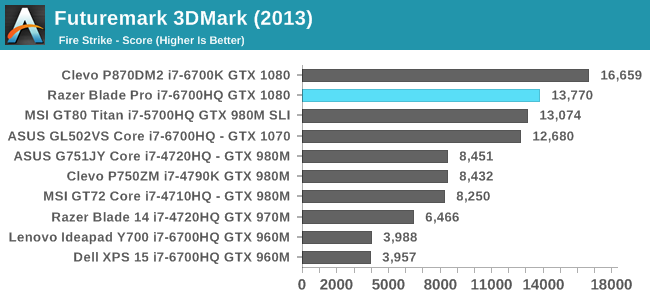
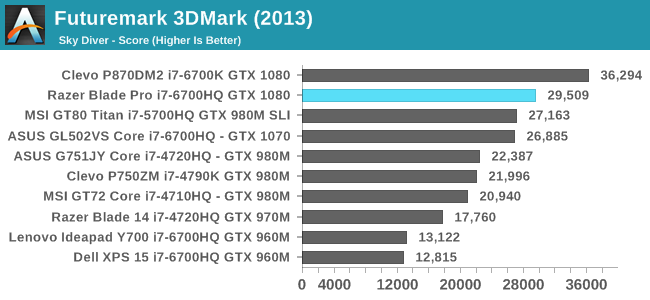

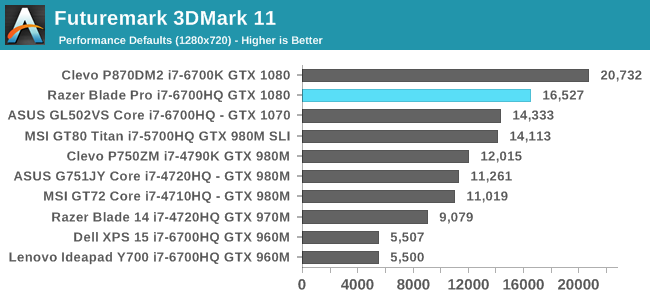
3DMark has evolved over the years to match the increasing performance of GPUs. In the newer, more GPU-intensive tests like Fire Strike, Sky Diver, and Cloud Gate, the Razer Blade Pro is right near the top of the chart. In Fire Strike and Sky Driver it wins against the MSI GT80 with it's dual GTX 980M GPUs, but it comes in a bit lower in Cloud Gate. The Clevo P870DM2 always comes in first as a result of its faster desktop CPU, which isn't unexpected. Overall, 3DMark shows the strong performance of NVIDIA's GTX 1080 and the Blade Pro.
GFXBench
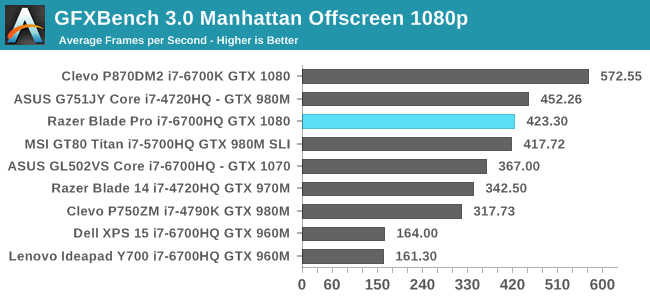

GFXBench basically exists for testing lower-performing laptops, as well as to verify that nothing is wrong with a laptop's performance for OpenGL titles. The Blade Pro performs as expected in both cases, sitting between the Clevo P870DM2 and the ASUS ROG Strix.
Dota 2 Reborn

Dota 2 is really CPU-bound at this point, with all the 6700HQ-based laptops achieving similar levels of performance. While the Blade Pro is at the same level as ASUS's GTX 1070 ROG Strix, the Clevo P870DM2 with its i7-6700K is nearly twice as fast as the Blade Pro despite using the same GPU. Ultimately this situation isn't unexpected for Dota 2, and the Blade Pro won't have any trouble with it even if the resolution is increased beyond the 1080p resolution that we test at.
Tomb Raider

Tomb Raider is perhaps the best showing for the Blade Pro, with performance being very close to that of the Clevo P870DM2, and significantly faster than any of the other laptops that we've tested.
Rise of the Tomb Raider

Rise of the Tomb Raider is a newer addition to our benchmark suite, so there aren't many results at this point. However, the order of the top results here mirrors the previous Tomb Raider test, with the Clevo P870DM2 at the top, followed by the Blade Pro, and the ASUS ROG Strix coming in third.
Civilization VI



Civ VI is a relatively new addition to the benchmark suite, and the only other laptop on record is the ASUS ROG Strix. As usual, Civ remains a more CPU-bound title, and with the same i7-6700HQ the Blade Pro performs essentially the same as the ROG Strix despite the difference in GPUs. Using one of Intel's faster CPUs would have helped differentiate the Blade Pro from other laptops in these CPU-bound titles, which would have avoided the awkward situation where a $3700 laptop doesn't perform any better than one which is less than half the price.
Bioshock Infinite
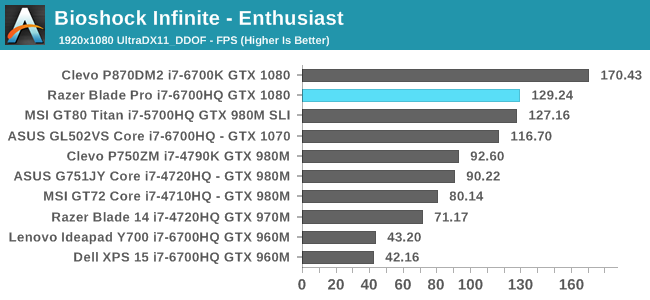
Bioshock Infinite is a case where the Blade Pro falls pretty far behind the Clevo P870DM2. I actually find the result of the P870DM2 to be somewhat questionable, as it seems higher than I would think is possible, so I can only assume that it must have been a really lucky run. In this case the Blade Pro performs slightly better than the MSI GT80 with its pair of GTX 980M GPUs, which is still quite a feat.
Dragon Age: Inquisition
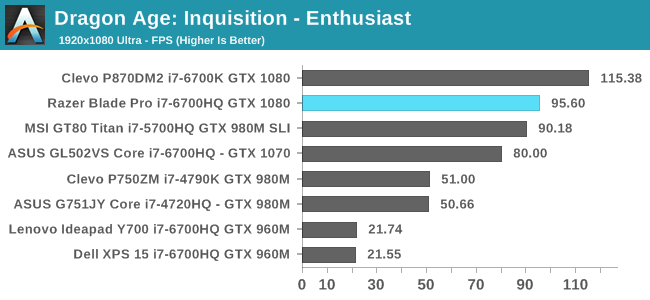
Dragon Age: Inquisition is one case where the Blade Pro is actually closer to the ASUS ROG Strix with its GTX 1070 than the Clevo P870DM2 which also uses GTX 1080. This is really something that depends on the game, and whether there are situations where the CPU becomes the limiting factor for performance. The performance is still significantly better than the GTX 1070, and noticably faster than a pair of 980Ms.
Shadow of Mordor
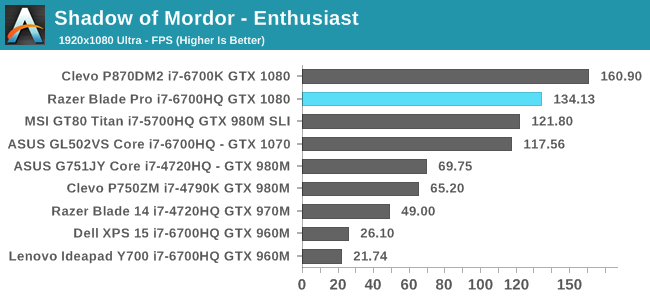
The Blade Pro performs well in Shadow of Mordor, although this is another case where the frame rate is slightly closer to that of the ASUS ROG Strix with its GTX 1070 GPU than the Clevo P870DM2. Still, the performance is quite impressive, especially when you consider how the Blade Pro is again surpassing the performance of the MSI GT80 which used a pair of GTX 980M GPUs and was the performance leader for laptops until the launch of NVIDIA's Pascal parts.
Grid Autosport
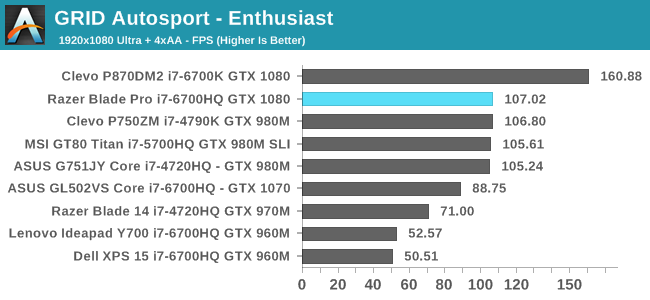
GRID is another case where machines become CPU limited at our test settings. The Blade Pro sits alongside several other laptops with lesser GPUs, while the Clevo P870DM2 has a large lead because of its desktop i7-6700K CPU. While Razer couldn't have put a 91W desktop CPU in their laptop, using a faster quad core mobile part could have improved performance here.
GPU Conclusion
When I first looked into gaming laptops many years ago as an interested consumer it was typically the case that NVIDIA's mobile parts reflected the performance of the GPU three tiers below that of the desktop card with a matching name. The performance that you can achieve in a notebook has gone up substantially since that time, and we're now seeing what are basically desktop parts shipping in laptops. In the case of the Razer Blade Pro, you have NVIDIA's GTX 1080, which is their flagship card for notebooks.
In the tests above it's clear that the Razer Blade Pro is one of the fastest notebooks on the market. The GTX 1080 provides a substantial increase in performance compared to laptops like the ASUS ROG Strix which use GTX 1070. However, if you were expecting the same performance as Clevo's P870DM2 you may be feeling somewhat left down. I was initially suprised by the gap, especially with the Razer Blade Pro being closer to the ROG Strix than the P870DM2 in some situations. After some examination, I've concluded that there isn't really any GPU throttling occuring, and looking at the titles where the gap is largest makes it evident that we're seeing the impact of differing CPUs. The Blade Pro's 2.6GHz i7-6700HQ is no slouch, but it's not going to keep up with a 4GHz i7 sitting in a desktop replacement that's twice as thick.
While this situation is unavoidable, there are two things I want to highlight. The first is that Razer could have, and should have used i7-6920HQ. I mentioned that on the previous page, and it bears repeating here. The Blade Pro is a premium laptop that starts at $3699. It's a machine that spares no expense, and it should be using Intel's fastest quad core chip. This would help in narrowing the gap between it and the P870DM2, and I'm pretty sure Razer would still bring in a healthy margin on the laptop.
The other point I wanted to mention is that the gap between the Blade Pro and the P870DM2 will be diminshed when running games at UHD. At that point the GPU becomes the limiting factor, and the difference in CPU performance has a smaller impact. Unfortunately, a single GTX 1080 really isn't sufficient to run modern titles at UHD unless you reduce the graphical settings to a point where the game probably looks worse overall than it did maxed at 1080p.
Ultimately, the Razer Blade Pro is still an incredibly fast machine, and 1080p is a perfectly suitable resolution to run games at on a 17-inch display. For example, I played through Deus Ex: Mankind Divided at max settings on the Blade Pro at 1080p and I was never bothered by scaling artifacts or aliasing. For $3699 I think Razer should have put in the fastest possible CPU in order to maximize performance, but as it is the Blade Pro is still highly capable and should be able to run modern games at high settings for the forseeable future.










57 Comments
View All Comments
digiguy - Monday, March 6, 2017 - link
yes, it would have only impacted cost (and maybe to a limited extent noise)fanofanand - Monday, March 6, 2017 - link
It would have impacted Razer's margins, nothing more. This is a cool laptop and all, but it's maybe $1500 worth of parts (for the $3800 version) with a massive markup.fanofanand - Monday, March 6, 2017 - link
Ok maybe $2,000. I just did a quick rundown of the BOM in my head, and even without Razer getting a sweetheart deal on any of the components (which of course they do) and the BOM is $2000-$2200. Either way there are margins there that Razer is I'm sure very pleased with. Even at this stratosphere It's probably harder to sell a $5k laptop than it is a $3k laptop, so they cut corners here and there. The reviewer aptly pointed out that the CPU and screen appear to be the two corners that were cut (and the stupid killer NIC).erple2 - Wednesday, March 8, 2017 - link
The screen is actually quite good, as evidenced by the calibrated results. In face, it's exceptional. The problem is that Razer went on the cheap and didn't calibrate it at the factory. That's not hard to do in a large production plant. If a $650 iPhone can have a very accurate screen and make a handsome profit margin, a $3000 laptop can easily, too.fanofanand - Monday, March 13, 2017 - link
The difference is that Razer is not the OEM for any of the components in their laptops, whereas Apple is vertically integrated to the point where they are making their own SOCs (even if they are fabbed elsewhere). What Apple does is vastly different than what Razer does. End users (at least 99.9% of them) would not calibrate their screen. Sure, professionals who need color accuracy would, but most people won't. That's why it's so important for these companies to do the calibrations ahead of time, so the end user can just buy the thing, plug it in, and be wowed.mobutu - Monday, March 6, 2017 - link
It's unacceptable for a modern machine to have those kind of bezels.DanNeely - Monday, March 6, 2017 - link
chassis size is set by the needed component and cooling volumes on this class of laptop. That means the only way for smaller bezels would be to use a bigger panel. Unfortunately the next bigger size, 18.4" is far more niche than even 17.3" (in conventional gaming laptop form factors it's almost exclusively used for SLI models); which means that Razer might not have been able to source a good high DPI panel. Assuming not, 1080p TN would be even worse.prophet001 - Monday, March 6, 2017 - link
Too much thermal throttling.You can't dissipate enough heat out of that laptop for a 1080.
jsntech - Monday, March 6, 2017 - link
Hey guys - we're at six months post-launch for the 2016 MBPs. I saw a comment a couple/few months ago about Ryan finishing up the review back then and am surprised it's taken so long to publish. Other outlets have obviously long since put up their reviews but have sadly (and as usual) fallen short of the detail I enjoy from AT reviews. Will we see it anytime soon? Are/were there issues with review samples, etc., or ?Aman5ingh - Tuesday, March 7, 2017 - link
"As time has gone on, Razer has iterated on the original Razer Blade, and introduced both a smaller model in the form of the Razer Blade Stealth, a 14-inch model to carry on the name of the original 17-inch Razer Blade..."Nope, the 12.5" model is called the Stealth (Intel HD Graphics), the 14" model is called the Razer Blade (which has a GTX 1060), and this one is the Pro.